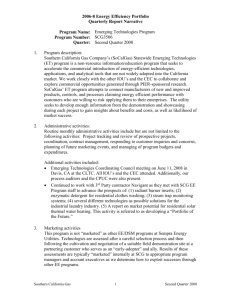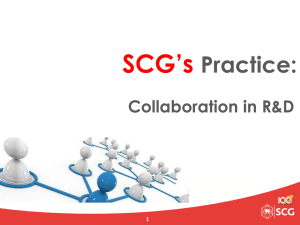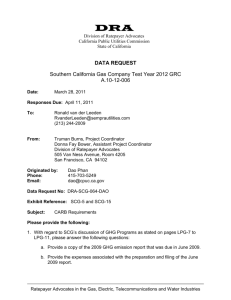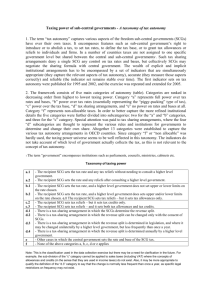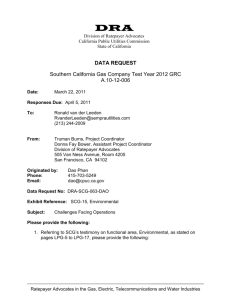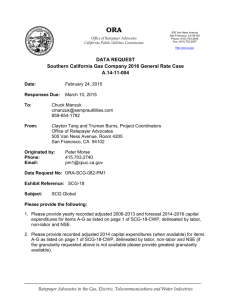Emerging Technologies
advertisement
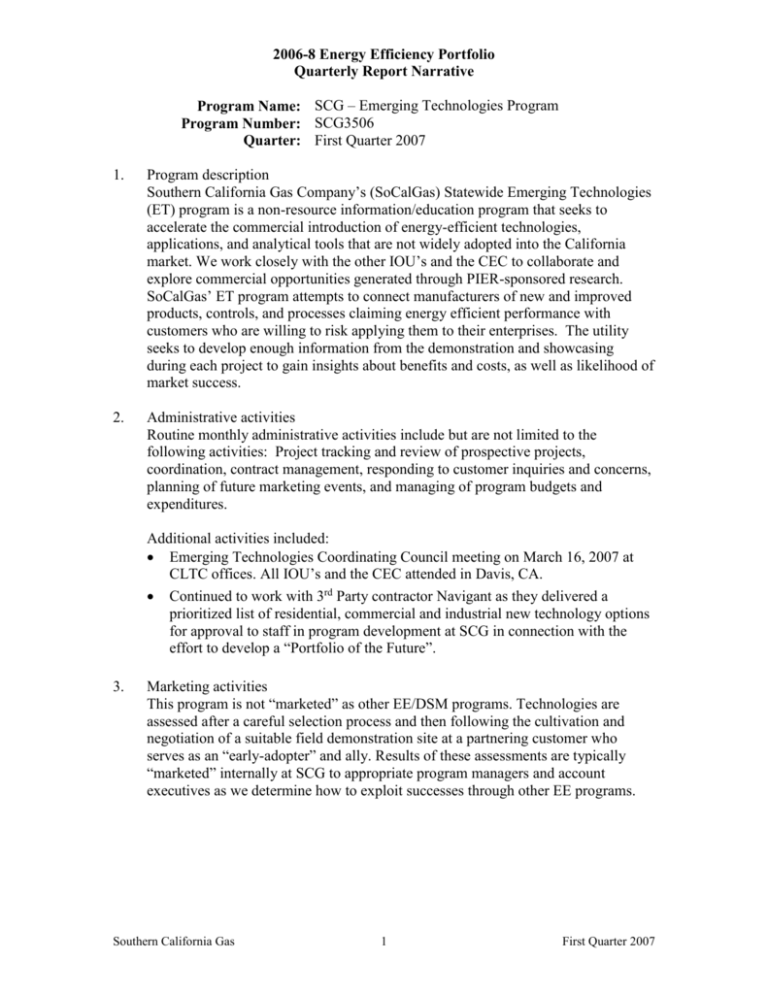
2006-8 Energy Efficiency Portfolio Quarterly Report Narrative Program Name: SCG – Emerging Technologies Program Program Number: SCG3506 Quarter: First Quarter 2007 1. Program description Southern California Gas Company’s (SoCalGas) Statewide Emerging Technologies (ET) program is a non-resource information/education program that seeks to accelerate the commercial introduction of energy-efficient technologies, applications, and analytical tools that are not widely adopted into the California market. We work closely with the other IOU’s and the CEC to collaborate and explore commercial opportunities generated through PIER-sponsored research. SoCalGas’ ET program attempts to connect manufacturers of new and improved products, controls, and processes claiming energy efficient performance with customers who are willing to risk applying them to their enterprises. The utility seeks to develop enough information from the demonstration and showcasing during each project to gain insights about benefits and costs, as well as likelihood of market success. 2. Administrative activities Routine monthly administrative activities include but are not limited to the following activities: Project tracking and review of prospective projects, coordination, contract management, responding to customer inquiries and concerns, planning of future marketing events, and managing of program budgets and expenditures. Additional activities included: Emerging Technologies Coordinating Council meeting on March 16, 2007 at CLTC offices. All IOU’s and the CEC attended in Davis, CA. Continued to work with 3rd Party contractor Navigant as they delivered a prioritized list of residential, commercial and industrial new technology options for approval to staff in program development at SCG in connection with the effort to develop a “Portfolio of the Future”. 3. Marketing activities This program is not “marketed” as other EE/DSM programs. Technologies are assessed after a careful selection process and then following the cultivation and negotiation of a suitable field demonstration site at a partnering customer who serves as an “early-adopter” and ally. Results of these assessments are typically “marketed” internally at SCG to appropriate program managers and account executives as we determine how to exploit successes through other EE programs. Southern California Gas 1 First Quarter 2007 2006-8 Energy Efficiency Portfolio Quarterly Report Narrative 4. Direct implementation activities Most of the funding, contracts and staff time are devoted to all the steps in the process of screening and evaluation of candidate new energy efficient technologies. Approximately twenty different project efforts are underway at various stages of the process. A number of new ideas are typically received or discovered each month. During 2006 the following assessments were begun and are continuing: Pulse combustion by way of a new industrial oscillating fuel valve applied to aluminum melting. Possible savings of 5-15% of gas input. Additional testing is planned to attempt to confirm some savings recorded in 2006 tests. Demonstration of “warm” asphalt mix in Escondido. Application of this technology could lead to large savings, but several more trials are needed. Another trial in Orange County is scheduled for early in the 2nd Quarter of 2007. Tankless water heater application in the food service industry testing anticipated at one major chain was postponed. Another chain restaurant has opted to work with SCG in the fast food segment. Plans to test a tankless water heater and two advanced cooking units (fryer and reheat oven) are in development. Evaluation of advanced boiler combustion control: these new technology offerings from well-known controls OEM’s will lead to new opportunities to add/retrofit equipment to a large population of existing boilers to stabilize low emissions and save energy. Breakdowns with the boiler at the customer’s plant have delayed installation of the control system. Testing is now expected in the 2nd and 3rd Quarters of 2007. Evaluation of improved IC Engine ignition and combustion trim control to improve efficiency while stabilizing VOC, CO and NOx emissions at low levels continues. Some improvements in the performance of 30 yr-old city water pumping engines has been recorded; but data is too thin and more results on other engines will be needed. Multi-family hot water loop distribution pump controllers have a potential to shave 10-15% from that gas load. Three different products are being screened and tests by laboratory simulation and field measurement at apartment buildings are now being planned throughout 2007. Heat recovery from large industrial refrigeration compressor motors to combine COP improvements with boiler load reductions will be evaluated at a whole milk processor. Delays due to management changes at the dairy were encountered, but the equipment was ordered late in 2006 and installation by 2nd Quarter 2007 is anticipated. This project is a collaboration with SCE. Heat recovery from large industrial boilers via condensing heat exchangers appears very attractive for the food processors. Application looks promising and paybacks short. Sidel Systems is working with a meat processor in the San Joaquin Valley. Delivery of the unit and installation will happen early in the 3rd Quarter with testing to begin shortly thereafter. Screening activities for other new technologies include: Southern California Gas 2 First Quarter 2007 2006-8 Energy Efficiency Portfolio Quarterly Report Narrative Discussions with City of San Diego Water Dept. were initiated to plan an evaluation of the energy and water savings potential of the “ShowerStart” product. A new engine by Deutz may present a great option for improving the efficiency of older natural gas engines for agricultural water pumping in the San Joaquin Valley. SCG is investigating the potential. An advanced CHP system by I-Power (ENI-85) is being evaluated in SCG’s EAC Laboratory in collaboration with EPRI and CEC. Radiant barrier products for homes and commercial buildings are being reviewed. New generation, very low NOx, conventional tank-type residential water heaters are expected for sale in California by fall of 2007. SCG plans to examine their energy and emissions performance in conjunction with the manufacturers interested in partnering with SCG. Among other possibilities is the development of data supporting an early replacement-type program. ElectraTherm and Carrier have introduced new products that recover otherwise wasted heat. Applications for these products will be investigated in 2007. A.O.Smith has produced a condensing water heater product called “VERTEX” for the residential market that SCG expects to test. Condensing boilers by Hamilton Engineering and others are candidates for evaluation in the industrial and commercial laundry segments. Other key activities Participated in the handoff of the SEGWHAI (residential water heater) concept (and project report) for further development to the Consortium for Energy Efficiency (CEE). 5. Program performance/program status (describe) Program is on target Program is exceeding expectations Program is falling short of expectations The Emerging Technologies programs of each of the IOU’s is evolving to achieve new standards of performance and effectiveness. The SEU programs are beginning to ramp up in resources as they continue with projects initiated in the prior cycle. Several new products are being screened with evolving selection criteria. 6. Program achievements (non-resource programs only): SCG has been active in screening several candidate project assessment ideas including new residential water heaters, residential zoning technologies, radiant barrier and “cool roof” technologies, industrial boiler heat recovery systems, Southern California Gas 3 First Quarter 2007 2006-8 Energy Efficiency Portfolio Quarterly Report Narrative advanced IC-engine controllers, and additional commercial market applications of tankless water heaters. 7. Changes in program emphasis, if any, from previous quarter (new program elements, less or more emphasis on a particular delivery strategy, program elements discontinued, measure discontinued, budget changes, etc.). None 8. Discussion of near-term plans for program over the coming months (e.g., marketing and outreach efforts that are expected to significantly increase program participation, etc.) SCG continues to explore new technology options; SCG communicates with CEC staff to review the PIER portfolio for assessment-ready opportunities. SCG is engaging in discussions with Navigant to explore alternative tactics for bringing more participation into the Emerging Technologies type of assessment process as a part of the “Portfolio of the Future” effort. Navigant will explore these tactics in connection with cold water (enzymatic) laundry detergent products, improved commercial dishwashers, solar water heating, and perhaps combustion sensors and controls. 9. Changes to staffing and staff responsibilities, if any Additions to the SCG ETP staff were anticipated to have been made in the 3rd or 4th Quarter, but internal issues have postponed the extra staffing until the 2nd Quarter of 2007. 10. Changes to contracts, None 11. Changes to contractors and contractor responsibilities, if any None 12. Number of customer complaints received None 13. Revisions to program theory and logic model, if any Sempra Energy Utilities ETP staff reviewed the EcoNorthwest process audit report. An internal team is working to incorporate suggestions into the ongoing development of the SCG-SDGE ETP Program model and process. A draft of the process is expected by the end of the 2nd Quarter. Southern California Gas 4 First Quarter 2007
